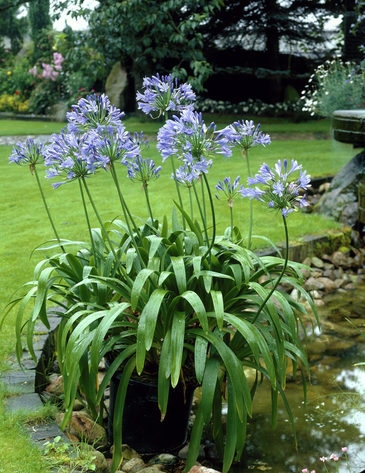Expanding Agapanthus: A Complete Overview to Beautiful Blooms
Expanding Agapanthus: A Complete Overview to Beautiful Blooms
Blog Article
Understanding the Art of Agapanthus Care: Vital Steps for Healthy And Balanced Growth and Lively Blooms
In the realm of cultivation, the growing of agapanthus stands as a fulfilling undertaking for those that seek to support these classy flowering plants. With their striking blooms and elegant foliage, agapanthus has actually caught the interest of gardeners worldwide. However, attaining ideal development and vivid blossoms needs a nuanced technique that encompasses numerous vital actions. From selecting the right variety to grasping trimming strategies, the trip towards growing prospering agapanthus plants is multifaceted and holds the key to unlocking the complete capacity of these herb treasures.

Selecting the Right Agapanthus Selection

When selecting the best Agapanthus range for your garden, consider factors such as climate suitability, bloom color, and development practice. Additionally, take into consideration the environment in your area to guarantee the Agapanthus selection you choose can grow in your specific conditions. Comprehending the development behavior of different Agapanthus ranges is critical for proper placement within your yard.
Suitable Planting Problems
Considering the optimal environmental needs is important for successful Agapanthus growing. Agapanthus flourishes in well-draining soil with a slightly acidic to neutral pH degree. When planting, choose an area that obtains full sunlight to partial shade. In hotter climates, giving some afternoon color can stop scorching of the leaves. Agapanthus plants are sensitive to cool temperature levels and need to be secured from frost throughout cold weather.
To ensure healthy and balanced development and lively blossoms, plant Agapanthus light bulbs at a depth of concerning 2-4 inches and space them 8-12 inches apart. Adding natural issue, such as garden compost, to the soil can boost drainage and fertility, promoting robust root development. Mulching around the base of the plants assists preserve wetness and reduces weed growth. Regular watering is critical, especially throughout the expanding season, to keep the soil regularly damp yet not waterlogged.
Watering and Feeding Tips
Maintaining appropriate moisture levels and giving essential nutrients are crucial elements in the care program for Agapanthus plants. It is critical to strike an equilibrium when it comes to sprinkling Agapanthus. If overwatered, these plants like constantly moist soil however are susceptible to root rot. Throughout the growing season, water deeply when a week, guaranteeing the dirt is well-draining to stop waterlogging. In hotter climates or during durations of dry spell, even more constant watering might be needed to maintain the dirt uniformly wet. Nevertheless, lower watering in the winter months to avoid water logged problems.
Feeding Agapanthus is vital for promoting healthy and balanced development and prolific flowers. Use a well balanced fertilizer, such as a 10-10-10 formula, in the very early springtime as brand-new growth emerges. Repeat this application every 6-8 weeks throughout the growing season. Stay clear of excessive fertilizing, as it can bring about lavish foliage at the expenditure of blossoms. Constantly adhere to the supplier's instructions for appropriate dilution and application methods. By following these watering and feeding suggestions, you can guarantee your Agapanthus plants prosper and generate vibrant, lasting blossoms.
Trimming Techniques for Agapanthus
Trimming Agapanthus plants at the proper times and with proper strategies is important for preserving their health and wellness and advertising ideal growth and flowering. The excellent time to trim Agapanthus remains in late winter season or early springtime prior to brand-new development arises. Begin by getting rid of any kind link of dead or yellowing leaves near the base of the plant. Cut them as short as feasible without damaging the arising shoots.
Deadheading invested flowers can also reroute the plant's power right into creating more blossoms rather than establishing seeds. If you want to gather seeds for breeding, leave some flowers to fully grown and completely dry on the plant.
Keep in mind to make use of clean, sharp tools to make specific cuts and lower the danger of introducing conditions. Agapanthus. Routine trimming will aid maintain your Agapanthus looking cool and healthy and balanced while making sure a plentiful display of lovely blossoms
Dealing With Common Bugs and Illness
After guaranteeing proper trimming techniques for Agapanthus, it is important to address typical insects and conditions that can influence the wellness and vitality of these plants. One common insect that affects Agapanthus is the Agapanthus gall midget.
One more common concern is fungal leaf spot, which offers as dark sores on the leaves. To prevent fungal diseases, make sure excellent air blood circulation around the plants, avoid above watering, and remove any infected leaves quickly. Furthermore, Agapanthus plants can suffer from root rot if they are planted in inadequately draining soil. To avoid this, plant Agapanthus in well-draining soil and prevent overwatering. By being attentive and taking timely activity against conditions and parasites, you can other aid your Agapanthus plants thrive and produce vibrant blooms.

Final Thought
Finally, understanding the art of agapanthus care includes picking the ideal range, offering optimal planting problems, correct watering and fertilizing, suitable trimming techniques, and dealing with usual pests and conditions. By complying with these necessary steps, you can guarantee healthy growth and vibrant blooms for your agapanthus plants. Keep in mind to routinely check and keep your plants to promote their general wellness blog here and long life.
To make certain healthy growth and vibrant blossoms, plant Agapanthus light bulbs at a deepness of about 2-4 inches and room them 8-12 inches apart. By adhering to these watering and feeding pointers, you can ensure your Agapanthus plants thrive and create vivid, resilient blossoms.
One typical pest that influences Agapanthus is the Agapanthus gall midge. Furthermore, Agapanthus plants can endure from origin rot if they are grown in poorly draining pipes dirt. By adhering to these crucial steps, you can guarantee healthy development and vivid blossoms for your agapanthus plants.
Report this page